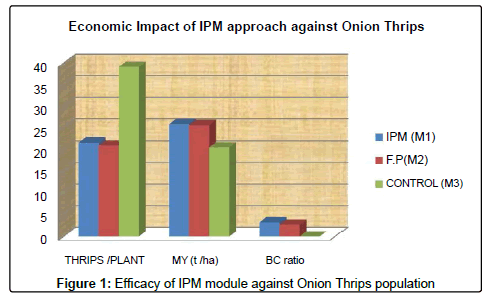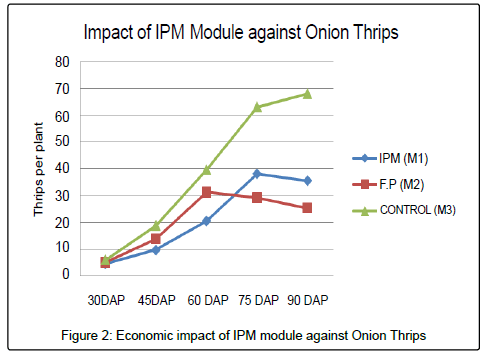Adoption of IPM Approach-An Ideal Module against Thrips (Thrips tabaci Linderman) in Onion
Received: 24-Mar-2014 / Accepted Date: 16-Jul-2014 / Published Date: 18-Jul-2014 DOI: 10.4172/2329-8863.1000136
Abstract
Onion (Allium cepa L.) is an important export oriented vegetable among the cultivated Allium crops in India. Onion Thrips (Thrips tabaci Linderman) is the key biotic factor for reducing yield loses in both onion as vegetable crop as well as seed crops. Besides direct damage to both foliage and bulbs, thrips can also indirectly aggravate purple blotch and act as a vector for viral disease such as Iris yellow spot. In absence of high levels of host plant resistance to Thrips tabaci and development of resistance towards number of pesticide of late, there is an urgent need to look at other IPM options for effective management. A field study was conducted under the All India Network Research Project on Onion and Garlic, at the College of Horticulture (OUAT), Sambalpur, Odisha, India during the winter season 2010-11 to 2012-13 to find out the most effective eco-friendly IPM modules for management of thrips in onion. The treatment consists of M1: IPM module, M2: Farmers’ Practices and M3: Control, laid out in RBD. The results obtained over three years indicated that both M1 and M2 not only significantly reduced the thrips population (21.68 and 21.02 thrips plant-1) but also increased total marketable yield (25.86 and 25.70 tha-1), respectively over the control, M3 (39.13 thrips plant-1 and 20.58 tha-1) . Higher BC Ratio was recorded in M1 (3.26) than M2 (2.70). It is concluded that adoption of the IPM module approach consisting of planting of border crop of two rows of wheat and one row of maize, 10-15 days prior to planting of onion seedling, dip treatment with Carbosulfan and need based insecticides spray, when thrips population exceed ETL (30 thrips/plant-1) not only reduces the thrips infestation but also increases the bulb yield with quality of onion bulbs.
Keywords: BC ratio; IPM; Marketable bulb yield; Onion Thrips; Thrips tabaci infestation
404588Introduction
Onion (Allium cepa L.) is an important export oriented vegetable among the cultivated Allium crops in India. It is grown in Rabi, Kharif as well as late Kharif seasons in India with maximum area of 60% in Rabi (winter) season alone. Onion Thrips (Thrips tabaci Linderman) is the key biotic factor for reducing yield loses in both bulb as well as seed crops in all seasons in onion. Besides direct damage to both foliage and bulbs, Thrips tabaci can indirectly aggravate purple blotch and vector for viral diseases, as well as Iris yellow spot [1] Thrips tabaci is now treated as the measure production constraints of onion at the national level in India [2] . Abundant literature is available on various aspects on onion thrips and their management in onion. Though host plant resistance is a crucial component of IPM, in absence of high levels of host plant resistance to Thrips and development of resistance towards number of pesticide of late. There is an urgent need to look at other IPM options for effective management of thrips. Keeping this in mind, the present study was carried out to study the effectiveness of IPM modules in onion crops against onion thrips.
Materials and Methods
The experiment was carried out under the All India Network Research Project on Onion and Garlic, at the College of Horticulture (OUAT), Sambalpur, Odisha, India during the winter season of 2010-11 to 2012-13. The three treatments used were: T1: IPM, T2 : conventional farmer practices and T3 : Control with 8 replication per treatment by adopting Randomized Block Design. The details of each treatment are given in Table 1.
| Sl.no. | Module | Details |
|---|---|---|
| 01. | T1:IPMmodule |
|
| 02. | T2:Farmers’ practice |
|
| 03. | T3:Control |
|
Table 1: Treatment Details of Evaluation of IPM Module for Onion Thrips
Onion seedlings variety Bhima Super of about 45 days old were transplanted in plot size of 250 m-2 for each module (40 beds of 3 m×2 m) with a spacing of 15 cm×10 cm on 20.10.2010 to 23.10.2010 ; 7.12.2011 to 9.12.2011 and 28.11.12 to 30.11.12, respectively . All recommended practices recommended by Directorate of Onion and Garlic Research (ICAR), Rajgurunagar, Pune, India, was adapted uniformly to all the modules except the insecticidal treatments which were adopted on the basis of the treatments. Insecticidal treatments were given as soon as thrips were recorded in treatment plots. The observations on thrips population were recorded at 30, 45, 60, 90 days after planting (DAP). The marketable bulb yield was recorded for each replication including only A+, A, B & C grade bulbs. The bolters, double, small size bulbs and rotten bulbs were excluded while calculating the marketable bulbs for this study. All data generated were subjected to statistical analysis and the efficacy different module was assessed P value at 5% level [3].
Results and Discussion
In the field study on efficacy of IPM module, the population of Thrips tabaci was significantly low in T1, (9.67 and 20.52 thrips/ plant-1) as compared to T2, conventional Farmers’ Practice (13.91 and 31.36 thripsplant-1) up to 60 DAP. Subsequently, the thrips plant-1 was significantly lower in farmers’ practice (29.27 and 25.42) than IPM plots (38.12 and 35.53), respectively. However, at all stages of observations both IPM and farmers’ practice significantly reduced thrips population up to 90 DAP and pooled results, except 30 DAP over the control plot (Table 2 and Figure 1). The non-significant effect on thrips population during the initial 30 DAP stage might be due to the initiation of thrips infestation stage. Similarly, the better efficacy of reducing the thrips population upto 60 DAP in IPM module might be due to border crop effect of both wheat and maize. Thrips are weak fliers and can be carried by the wind. Therefore, planting live barriers like maize and wheat could effectively block or reduce adult thrips reaching onion plants. Similar report of efficacy of border crop – maize and wheat to block thrips in onion has been reported by [4]. On the other hand, significant reduction in thrips population after 75 and 90 DAP in farmers’ practice over IPM might be due to senescence of boarder crop effect, both at wheat and maize. On the contrary, due to repeated spraying of insecticides, the thrips population was well under control in T2, the farmer’s practice (Figure 1).
| Module | Thrips/plant-1after | MY(t/ha) | BCR | |||||
|---|---|---|---|---|---|---|---|---|
| 30DAP | 45DAP | 60DAP | 75DAP | 90DAP | Pooled | |||
| M1 (IPMModule) |
4.54 (2.24) |
9.67 (3.18) |
20.52 (4.58) |
38.12 (6.21) |
35.53 (6.00) |
21.68 (4.71) |
25.86 | 3.26 |
| M2(Farmer’spractice) | 5.13 (2.37) |
13.91 (3.78) |
31.36 (5.64) |
29.27 (5.46) |
25.42 (5.09) |
21.02 (4.64) |
25.70 | 2.70 |
| M3(untreatedcontrol) | 5.97 (2.54) |
18.81 (4.39) |
39.65 (6.34) |
63.16 (7.98) |
68.05 (8.28) |
39.13 (6.29) |
20.58 | |
| Grandmean | 5.21 (2.38) |
14.13 (3.79) |
30.51 (5.62) |
43.52 (6.55) |
43.00 (6.45) |
27.28 (5.21) |
24.05 | |
| Sem± | 0.09 | 0.16 | 0.12 | 0.14 | 0.20 | 0.10 | 0.62 | |
| LSD5% | 0.23 | 0.39 | 0.29 | 0.35 | 0.50 | 0.23 | 1.52 | |
Table 2: Efficacy of IPM Modules against Onion Thrips under Odisha Condition (mean value of 2010-11 to 2012-13)
The thrips population counts pooled over all the stages of observations from 30-90 DAP, indicated significant reduction in thrips population in both IPM and farmers’ practice over control plots. Significantly lowest thrips/plant-1 was recorded in farmers’ practice (21.02) over control plot (39.13). However statistical parity was observed between IPM and farmers’ practice indicating that both the treatments were equally effective in reducing thrips population in onion crops. The pooled results over 2010-11 to 2012-13 on marketable bulb yield revealed significant variations ranging from 20.58 tha-1 in control to 25.86 tha-1 in IPM plot with a mean value of 24.05 tha-1 (Table 2 and Figure 2). Significantly highest marketable bulb yield was recorded in IPM plots (25.86 tha-1) than control (20.58 tha-1). However, IPM and farmers’ practice and (25.86 and 25.70 tha-1) was non-significant statistically indicating the better efficacy of IPM modules.
The economics of marketable bulb yield in onion mean over three years revealed that adoption of IPM treatments was best with highest Benefit Cost ratio of 3.26 than farmers’ practices (2.70). The higher BC ratio in IPM plot is primarily due to less insecticidal application [1] and additional income from the border crop – maize & wheat as compared to farmers’ practice. Similar report of highest BC ratio was estimated in control plots between 45-75 DAP in onion [5].
Conclusion
It is concluded that adoption of IPM module approach consisting of planting border crops of two rows of wheat and maize, 10-15 days prior to planting, seedling dip treatment with Carbosulfan and need based insecticides spray, when thrips population exceed threshold levels (30 thrips/plant-1) not only reduces thrips infestation but also increases the bulb yield with quality bulbs in onion.
Acknowledgements
We gratefully acknowledge the Orissa University of Agriculture & Technology, Odisha, India for the research facilities provided and to the Director, Directorate of Onion & Garlic Research (ICAR), Rajgurunagar, Pune, India for providing the financial & other facilities to carry out this study under AINRP on Onion and Garlic
References
- Krishna Kumar NK, Srinivas PS, Rebjit KB, Asokan R, Ranganath HR (2011) Onion thrips Thrips tabaci Linderman : a prospective. In: National Symposium on Allium: Current Scenario and Emerging Trends, Pune 68-76.
- Srinivas PS, Lawande KE (2004) Impact of planting dates on Thrips tabaci Linderman infestation and yield loss in onion (Allium cepa L.) Pest management in Horticultural Eco- system, 10:11-183.
- Sukhatame, PV, Amble VN (1995 )Statistical Methods for Agricultural workers. ICAR, New Delhi 145-156.
- Srinivas PS, Lawande KE (2006) Maize border as a cultural method for management of thrips in onion (Allium cepa L.). Indian journal of Agricultural Science 76: 167-171.
- Srinivas PS, Lawande KE (2008) Growth stage susceptibility of onion (Allium cepa L.) and its role in thrips management. Indian journal of Agricultural Science 78: 98-101.
Citation: Tripathy P, Sahoo BB, Das SK, Priyadarshini A, Patel D et al. (2014) Adoption of IPM Approach- An Ideal Module against Thrips (Thrips tabaci Linderman) in Onion. Adv Crop Sci Tech 2:136. DOI: 10.4172/2329-8863.1000136
Copyright: © 2014 Tripathy P, et al. This is an open-access article distributed under the terms of the Creative Commons Attribution License, which permits unrestricted use, distribution, and reproduction in any medium, provided the original author and source are credited.
Select your language of interest to view the total content in your interested language
Share This Article
Recommended Journals
Open Access Journals
Article Tools
Article Usage
- Total views: 16574
- [From(publication date): 11-2014 - Aug 30, 2025]
- Breakdown by view type
- HTML page views: 11793
- PDF downloads: 4781


